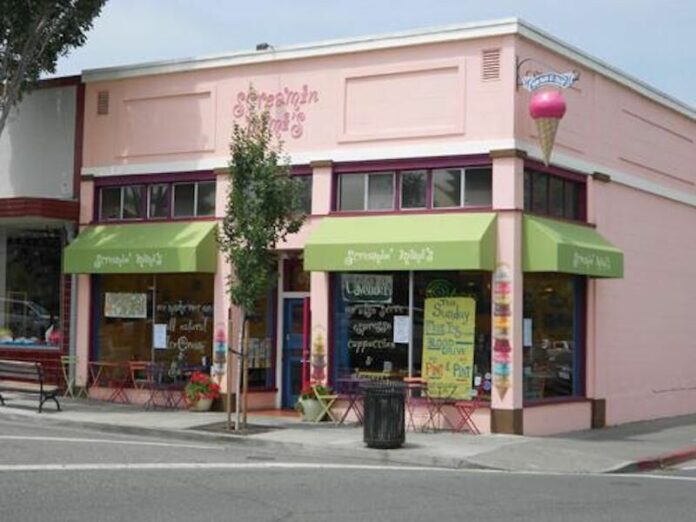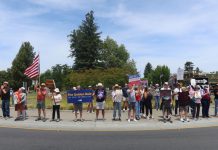Caltrans will review and approve plans for outdoor seating downtown
The Sebastopol City Council decided at its meeting on Oct. 6 to advance an application to establish temporary parklets in downtown Sebastopol to the California Department of Transportation (Caltrans) for review.
Parklets are spaces for tables and seating open to the general public installed over designated parking spaces and sidewalks, a popular compromise across the country between restrictions barring indoor business operations and those businesses striving to stay afloat.
A local group led by Councilmember Sarah Gurney and Paul Fritz, vice chair of the Sebastopol Planning Commission, pushed for parklets to address the financial hit of COVID-19 that limited businesses to curbside pick-up and whatever outdoor dining they already had.
Ultimately, the council voted unanimously to submit the application for four parklets in the city’s name. Mayor Patrick Slayter directed the Planning Department to assign staff to call business owners who would be most impacted by the installations for a more neutral survey on whether they supported the project.
Slayter said he wrote and sent a letter as authorized by the council to the state and had been in contact with someone from the governor’s office and with Senator Mike McGuire. He said he was also in conversation with the mayors of Sonoma and St. Helena about the parklet process.
Councilmember Neysa Hinton said she also forwarded Slayter’s letter to McGuire’s office and Assemblymember Marc Levine’s office. She updated the council that McGuire’s office emailed her saying the office is working on Sebastopol’s case specifically, and that they met last week with legislative staff from the Caltrans headquarters in Sacramento and the Caltrans district director responsible for the Bay Area. Hinton said they were trying to get Sebastopol’s parklet project fast-tracked.
Gurney said the group committed to find out if business owners supported the idea. She reached out to Linda Collins of the Chamber of Commerce, Rei Blaser from the Sebastopol Downtown Association, Danielle Connor from Retrograde Coffee Roasters, and Maralene Olson from Screamin’ Mimi’s.
“There’s a lot of enthusiasm for bringing people to all of our downtown so they’re able to walk from here to there, to have this socially-distanced, outdoor holiday experience,” she said. “So, we have a great opportunity to market a united downtown and repopulate it with our citizens, to market it and potentially bring in holiday celebrants, holiday shoppers.”
The first week of October has gone by and the timeline is tight. But the main hurdle the project must overcome is that it requires state-level approval, since Caltrans has right-of-way in some of Sebastopol’s downtown streets.
The group and city staff initially proposed three parklets — one located in front of Screamin’ Mimi’s on the north side of Sebastopol Avenue; one on the west side of North Main Street in the block between McKinley Street and Bodega Avenue, south of the McKinley crosswalk; and one on the west side of South Main street, mid-block between Bodega Avenue and Burnett Street. Fritz suggested a fourth parklet during the hourlong project discussion.
The staff report outlining the project notes that many city restaurants sit along Highway 12 and Highway 116, and the requirements to qualify for a Caltrans permit to occupy state right-of-way are grueling, according to Engineering Manager Henry Mikus.
Mikus said this includes a restriction that bans commercial activities like table service or monetary transactions at the parklets. Parklets must also be designated for public use, ADA accessible, not owned by or assigned for commercial use and must include safety barriers for traffic.
Yet, Mikus noted that the City of Saratoga managed to get some other challenging demands put into abeyance and obtain a Caltrans permit within days of submitting an application. Their success did not necessarily mean Sebastopol would be so lucky, he said.
“Caltrans turnaround for review is unknown,” Mikus said. “Our experience, frankly, over the last five years, has been all over the map. We’ve had some permits come back within a week, and then we’ve had some go through eight iterations crossing a year and a half. I can’t even begin to predict what this might be like.”
The next steps after city council approval is to pass a council resolution, submit an application with project designs to Caltrans, get city approval for the cost of renting or buying barriers and seek donations for the ADA materials, according to Mikus’ presentation. Caltrans created a guidance document for cities trying to get permits for parklets, which specifies the city must submit a project narrative, site plans, photos, and meet Caltrans design requirements.
Later in the discussion, Fritz said he was talking with the engineer from Saratoga and using their application as a guideline. When Slayter asked about possible configurations involving cross-slopes for ADA compliance, Fritz said the Saratoga project did not have to do everything Mikus outlined, and that there was even more than Mikus did not include in his outline that Caltrans requires.
“I mean, they literally just took the diagram in the Caltrans guidelines and said, ‘This is what we’re going to do.’ And absolutely no detail, they didn’t even show the K-rails, they didn’t show the ramp, they didn’t have kind of anything. So it was much, much reduced kind of drawing requirements,” Fritz said.
He said Saratoga had a similar street situation and Caltrans didn’t take an issue with their design so long as their accessible ramp was compliant.
A question Fritz would like to pose to Caltrans was whether they would consider tables adjacent to the curb and parklet to be accessible tables, where people could still sit but where the on-street parklet area would be for people who could step down the sidewalk curb for a “side-by-side, equivalent facility.” He added, “I don’t know if Caltrans would see that or not.”
Fritz has already started seeking donations for building materials and volunteers to help construct the accessible ramps, according to the staff report. The report also said the project would promote something similar to Saratoga’s “adopt a parklet” strategy inviting businesses to lend tables and chairs and help keep the areas clean. Diana Rich, a member of the Sebastopol Rotary Club, offered Fritz the club’s support for construction during public comment.
Councilmember Michael Carnacchi introduced a scenario where drivers headed south on North Main Street might not be familiar with the lane markings affected by downtown construction where the road splits into two lanes by McKinley Street, and a car could be forced into a parklet on the side of the road during the shift to the right.
Carnacchi said he could contact Caltrans again about when they would re-stripe the road for drivers and that it would be safer to use concrete k-rails, or traffic barriers, instead of plastic ones for the parklets’ end pieces.
Fritz said the Saratoga project went forward with the plastic K-rails, and while concrete K-rails were sturdier, Public Works Superintendent Dante Del Prete was concerned that he did not have the equipment that could transport concrete barriers. Carnacchi said he knew of a company that would not be too expensive to contract for the job if the city could get traffic control out on the street.
Attendee Nate Burson said he opposed the parklet project during public comment because the parklets could increase chances of COVID-19 exposure downtown by allowing more areas for people to gather without masks on.
“I get that you want to make money, but you’re putting people at risk. I mean, if Saratoga and Petaluma jump off a bridge, do you jump off a bridge because they jump off a bridge? Or do you say, ‘Hey, we’re coming into winter, there’s COVID-19. Flu season’s coming in. There’s elderly people in town,’” he said. “It feels like you’re begging to increase the numbers.”
Another attendee, Kyle, said his only concern was that the council coming together this late in the fall with El Niño rains on the way may be “too little, too late” since earlier movement on the project could have brought revenue to downtown businesses for many months now.
Another person at the meeting encouraged the council to go forward with the parklets, even if it was late in the game.
The original project plans estimate a funding request of $8,500 from the council, with $7,500 allotted for the K-rails and $1,000 left for unexpected expenses.
The council decided to resume discussion at their next meeting on Tuesday, Oct. 14 for budget adjustments after Del Prete could do more research on K-rails and Caltrans standards per the council’s request to make the K-rails as safe as possible.









